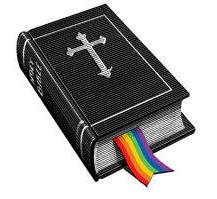What the Bible really says about Homosexuality (it’s not what you think)

Conservative opponents of same sex marriage have a lot of homework and explaining to do.
“Given the appeal to the Bible in the case of homosexuality, one would assume that the Bible has much to say on the subject. It has not. The subject of homosexuality is not mentioned in the Ten Commandments, nor in the Summary of the Law. No prophet discourses on the subject. Jesus himself makes no mention of it, and homosexuality does not appear to be of much concern to those early churches with which Saint Paul and his successors were involved. One has to look rather hard, and with a user-friendly concordance, to find any mention of homosexuality at all. This should come as no surprise, because the word ‘homosexuality’ itself is an invention of the late nineteenth century and does not occur in any of the original manuscripts from which the English Bible is descended. As historian John Boswell has pointed out in his magisterial 1980 study, ‘Christianity, Social Tolerance, and Homosexuality.’
‘In spite of the misleading English translations which may imply the contrary, the word ‘homosexual’ does not occur in the Bible; no extant text or manuscript, Hebrew, Greek, Syrian or Aramaic, contains such a word. In fact none of these languages ever contained a word corresponding to the English ‘homosexual,’ nor did any language have such a term before the late nineteenth century.’
Victor Paul Furnish (‘The Moral Teaching of St. Paul’) goes on to remind us that the King James Version of 1611 makes no mention of homosexuality or of any of its cognates, and that the first use of the term in an English Bible is to be found in the Revised Standard Version of 1946…There is no doubt, however, that you would not have found the word in a Bible in any language before 1946. The significance of this process whereby contemporary meanings associated with the term ‘homosexuality’ and its cognates are applied to biblical situations from which the contemporary understanding may well be absent is one we will discuss in reviewing the texts in question.”
~Peter J. Gomes, "The Good Book: Reading the Bible With the Mind and Heart" (Ch. 8)
Here I would suggest a close reading of Peter J. Gomes chapter on "Homosexuality In the Bible" in which he covers each of the six passages, O.T.. and N.T. with academic care and nuance.
It can be found in his book "The Good Book."
Then if certain matters apply to Jews than apply to Gentiles, then it is not so clear to apply the teaching:
""Do not think that I have come to abolish the Law or the Prophets; I have not come to abolish them but to fulfill them. For truly, I say to you, until heaven and earth pass away, not an iota, not a dot, will pass from the Law until all is accomplished. "
In any case, the O.T. doesn't even address homosexuality. It addresses "sodomite offenders." This does not refer to people in same sex relationships, as people in the ancient Semitic world had absolutely no conception of (either)
I. People who are solely attracted to people of the same sex
II. An arrangement in which homosexual people could be in a monogamous relationship.
In that way, it's absurdist to claim that ancient people were condemned something that they didn't know existed.
"Sodomite offenders" like those addressed in the story of Sodom and Gomorrah, are not referring to homosexual people having consensual sex in a relationship. That much is manifestly clear in the text itself.
I would read it so closely, also in the Greek, as the terms 'malakoi' and 'arsenokoitai,' refers to man/boy relationships in the Hellenistic world. Pedophiliac relationships between a presumably married man, and a pre-pubescent teen. These are the terms that Paul uses to address homosexuality in every instance save one.
There's a reason that the term "homosexual" didn't show up in the New Testament until 1956 with the first edition of the Revised Standard Version-- that's because it's a poor translation.
In Romans 1, Paul speaks of women who have natural desires for men, "trading in those natural desires" to lay with other women.
In what world is a woman who naturally is attracted to men gay?
Another sloppy interpretive misunderstanding. Paul here is referring to the Roman cultus where women in conventional heterosexual relationship would engage in communal sex as part of a ritual act-- that would entail adultery, polyamory, and pagan worship for...... women whose "natural desires" are for men.
Look closely indeed.
Congratulations @la2410! You have completed some achievement on Steemit and have been rewarded with new badge(s) :
Click on any badge to view your own Board of Honor on SteemitBoard.
For more information about SteemitBoard, click here
If you no longer want to receive notifications, reply to this comment with the word
STOP